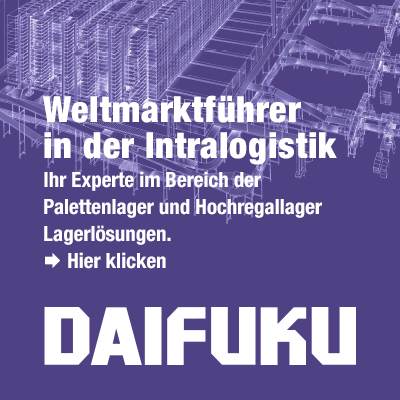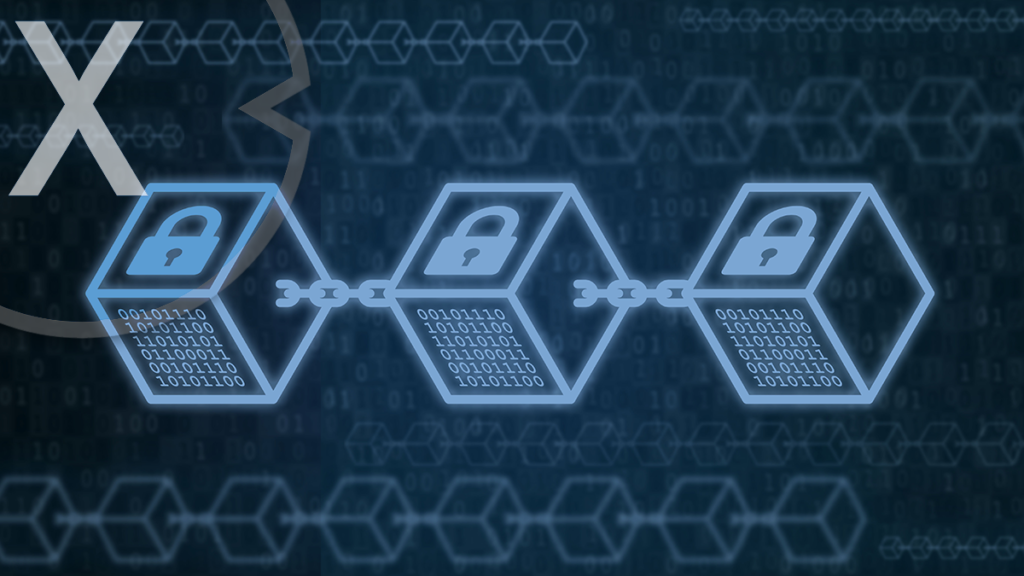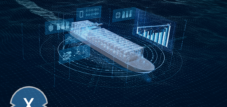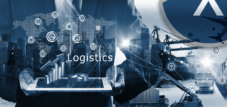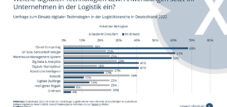Automated Logistics Premium: Using digital twins and blockchain to manage complex and global supply chains
Language selection 📢
Published on: August 30, 2024 / update from: September 5, 2024 - Author: Konrad Wolfenstein

Automated Logistics Premium: Using digital twins and blockchain to manage complex and global supply chains - Image: Xpert.Digital
The use of blockchain in global logistics: A simply explained concept and the role of the digital twin in simplifying complexity 📦🔗
🚚 Global logistics is facing major changes, driven by the use of blockchain technology and digital twins. These technologies promise not only more efficient, but also more transparent and safer handling of complex global supply chains. To better understand the potential of these technologies, it is important to know the basics and how blockchain and digital twins work.
Suitable for:
What is Blockchain and how does it work? 💡
Blockchain is a digital technology that allows data to be stored in a decentralized, immutable and transparent manner. Imagine a chain of blocks, where each block contains information that is linked to the information in the previous block. This chain of blocks (hence the name “blockchain”) is stored on many different computers at the same time, making it nearly impossible to manipulate or change the data.
In practice, this means that every transaction that takes place on the blockchain is visible to everyone involved and cannot be reversed. This transparency and immutability make blockchain technology an ideal tool for logistics, where trust and efficiency are crucial.
An example of the application of blockchain in logistics is tracking goods in real time. Imagine a container full of goods being shipped from one country to another. With Blockchain, every movement of this container, from loading to shipping to unloading, can be recorded in the Blockchain. Everyone involved, from suppliers to freight forwarders and recipients, can view the current location and status of the goods at any time. This visibility significantly reduces the risks of delays, loss or theft and improves the efficiency of the entire supply chain.
The advantages of blockchain in global logistics 🌍
The use of blockchain in global logistics offers numerous advantages. One of the most obvious is increased transparency. Traditional supply chains often involve a large number of intermediaries and service providers, making it difficult to keep track of the movement of goods. With blockchain, every transaction in the supply chain can be tracked in real time, greatly improving transparency.
Another advantage is security. Since every transaction on the blockchain is cryptographically secured, the data is extremely difficult to manipulate. This is particularly important in global logistics, where forged or manipulated documents can result in significant financial losses.
In addition, blockchain can significantly increase the efficiency of logistics. By automating processes such as processing payments or issuing shipping documents, costs can be reduced and the speed of the supply chain increased. Smart contracts, which are executed automatically when certain conditions are met, play a key role here. They make it possible to release payments automatically when, for example, a delivery has been successfully completed.
What is a digital twin and how does it simplify complexity? 🌐
A digital twin is a virtual image of a physical object or process. It allows physical systems to be monitored, analyzed and optimized in real time by creating a digital copy of these systems. In logistics, for example, a digital twin can represent a physical container, a warehouse or even an entire supply chain.
By using digital twins, companies can monitor the health and performance of their physical systems in real time. This allows them to identify problems early and fix them before they become major disruptions. Combined with blockchain, the Digital Twin offers an even more comprehensive solution by connecting the physical world with the digital world.
For example, a company could create a digital twin of a container that is monitored in real time. If the container deviates from its planned route or suffers damage, this can be immediately detected and documented on the blockchain. Affected parties can then quickly take action to resolve the issue, minimizing the impact on the supply chain.
The synergy of blockchain and digital twin in global logistics 🔄
The combination of blockchain and digital twin has the potential to fundamentally change global logistics. By integrating these two technologies, companies can optimize and secure their supply chains in unprecedented ways.
Blockchain technology ensures that all transactions and data are tamper-proof and transparent. At the same time, the Digital Twin enables precise monitoring and analysis of the physical systems in real time. This synergy leads to a significant reduction in risks and an improvement in efficiency.
An example of this is the monitoring of temperature-critical deliveries, such as in the pharmaceutical industry. A digital twin of a refrigerated container could continuously monitor the temperature, humidity and other relevant parameters. This data is stored on the blockchain and can be viewed by everyone involved. Should there be a deviation, such as an increase in temperature, this will be detected immediately and all parties involved will be alerted. This allows for a quick response to ensure product quality and avoid losses.
Challenges and future prospects 🔧
Despite the many advantages, there are also challenges when using blockchain and digital twins in global logistics. One of the biggest hurdles is interoperability between different blockchain platforms. Since many companies use different blockchain systems, it can be difficult to link these systems together and ensure seamless communication.
Another problem is scalability. Although blockchain is a very secure technology, it can become slow and expensive with a large number of transactions. This is particularly important in global logistics, where millions of transactions take place every day.
Nevertheless, the potential of these technologies is enormous and they are expected to continue to grow in importance in the coming years. Companies that adopt blockchain and digital twins early could gain a significant competitive advantage by making their supply chains more efficient, secure and transparent.
The future of global logistics lies in digitalization, and blockchain and digital twins play a central role in this. While the challenges should not be underestimated, the benefits clearly outweigh them. Companies that successfully implement these technologies will be able to respond more quickly to market changes, reduce costs and provide better service to their customers.
Ways to improve efficiency, transparency and security 🛠️
Integrating blockchain and digital twins into global logistics opens up new opportunities to improve efficiency, transparency and security. By combining the tamper-proof and transparent nature of blockchain with the real-time monitoring and optimization capabilities of digital twins, companies can revolutionize their supply chains.
The challenge ahead is to improve the interoperability and scalability of these technologies to achieve their full potential. The future of global logistics will undoubtedly be shaped by these digital innovations, and companies that embrace these changes early will be able to position themselves as leaders in their industry in the long term.
📣 Similar topics
- 🚚 Revolution in global logistics: Blockchain and digital twins
- 🔗 Blockchain in Global Logistics: An Overview
- 🌍 Blockchain and Digital Twins: A perfect synergy for logistics
- 🛠️ What is blockchain and how does it work?
- 🏆 Benefits of Blockchain in the Global Supply Chain
- 🧠 What is a digital twin and how does it simplify logistics?
- 🚛 Digital Twins and Blockchain: The Future of Global Logistics
- 📈 Efficiency, transparency and security through blockchain
- ⚙️ Challenges and future prospects for blockchain and digital twins
- 💡 Opportunities to improve global logistics
#️⃣ Hashtags: #DigitaleLogistik #Blockchain #DigitalTwin #Efficiency #Transparency
Xpert partner in warehouse planning and construction
🔗🌍🚚 Blockchain Technology Blog
It is important to understand that blockchain technology is not just limited to the financial sector (fintech/fintech, digital currencies/cryptocurrencies). The technology is increasingly being used in other industries such as healthcare, supply chain, real estate, gaming, identity management and more. Blockchain technology has the potential to impact and revolutionize many areas of business and daily life.
Blockchain technology is also an important part of the technology industry and represents innovative solutions in the way data and values can be managed and transferred securely and traceably over the Internet. The decentralized nature of blockchain and the security it offers make it a disruptive force in various sectors.
More about it here:
📊🌐 The concept of digital twins 📡🔧🚛 – further development in supply chains
Introduction to the concept of digital twins
🛠🔍 Digital twins are virtual representations of physical objects or processes that use real-time data from sensors and other sources to enable digital comparison with reality. Originally developed in the manufacturing industry, they have now become a key tool for optimizing and monitoring complex systems, including supply chains.
The idea behind digital twins is that they make it possible not only to monitor physical systems, but also to control and simulate them. This capability opens up new opportunities for companies to make their supply chains more efficient and resilient. By integrating data from various sources, such as production facilities, logistics systems and distribution networks, companies can get a comprehensive picture of their supply chains and optimize them in real time.
Application in supply chains
🚚🔗 The application of digital twins in supply chains has the potential to create unprecedented transparency and control. By digitally mapping the entire supply chain, companies can react to changes in real time, better manage risks and optimize processes.
A central element of this technology is the so -called “Addressability”, that is, the ability to clearly and permanently identify each element within the supply chain. This enables every component to track every component, every material and transport movement and to be controlled if necessary. This ability is particularly important for complex supply chains, such as those found in the automotive or electronics industry.
Challenges and technological requirements
⚙️🔒 However, the introduction of digital twins in supply chains also brings challenges. One of the biggest hurdles is creating a unified data model capable of representing the different elements of a supply chain. This requires not only technological innovation, but also close collaboration between the different actors in the supply chain.
Another important issue is data security. Because digital twins process a variety of sensitive data in real time, strict security protocols must be implemented to prevent unauthorized access to this data. This includes both protecting the data itself and ensuring that the data is authentic and unchanged.
Blockchain as a supporting technology
🔗📜 A technology that is of particular interest in connection with digital twins is blockchain. Due to its ability to store data immutably and transparently, blockchain offers an ideal complement to digital twins in supply chains. It makes it possible to verify the origin and authenticity of products, which is particularly important in industries with high product safety requirements, such as the food or pharmaceutical industries.
For example, combining digital twins with blockchain technology could significantly improve product traceability. In practice, this means that a company would be able to monitor and document the entire life cycle of a product, from raw material to end user. This could not only increase supply chain efficiency, but also improve transparency with customers and regulators.
Case study: battery recycling
🔋♻️ A particularly illustrative application example for digital twins in supply chains is the recycling of batteries, especially in the context of electric vehicles. The digital twin can be used to track the entire life cycle of a battery, from production to use in the vehicle to recycling.
By using a digital twin, each battery can be equipped with a digital product passport (DPP) that contains all relevant information, such as the origin of raw materials, production data and usage history. This passport is continuously updated as the battery is processed at different stages of its life cycle. For example, workshops can access and update battery data during maintenance work, which is later crucial for recycling.
Future prospects
🔮🚀 The future of digital twins in supply chains is promising. With the continuous development of technologies, particularly in the areas of data management, blockchain and artificial intelligence, digital twins will play an even more important role in optimizing global supply chains in the coming years.
The integration of digital twins into supply chains offers enormous potential to increase the efficiency, transparency and resilience of companies. At the same time, however, realizing this potential requires significant technological and organizational efforts to overcome the existing challenges and create the necessary standards and infrastructure. However, with the right strategy and the right technological solutions, digital twins could soon be an indispensable part of modern supply chains.
📣 Similar topics
- 🔍 Digital twins at a glance
- 🚀 Innovations in supply chains
- 🛡️ Security aspects and data integrity
- ⚙️ Technological requirements
- 🔗 Blockchain and digital twins
- 🔄 Focus on recycling batteries
- 🌍 Future of supply chain optimization
- 📊 Data management and transparency
- 🚚 Logistics and digital twins
- 💡 Strategic implementation
#️⃣ Hashtags: #DigitalTwins #Supply Chains #Blockchain #Data Management #Innovation
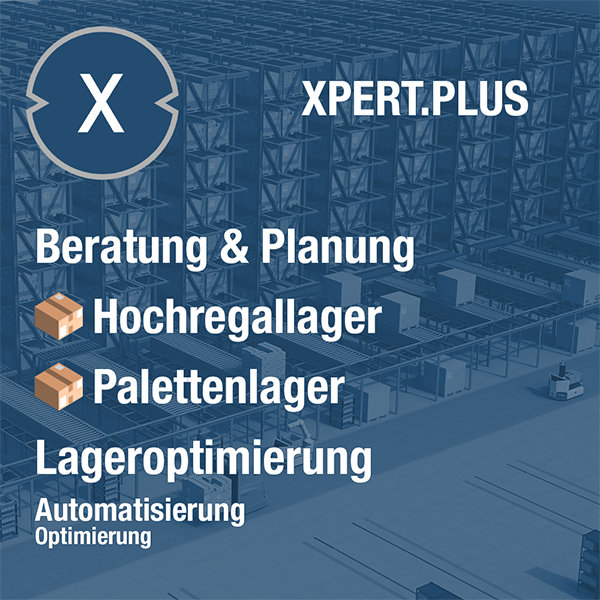
Xpert.Plus warehouse optimization - high-bay warehouses such as pallet warehouses consulting and planning
🌐🔗 Digital Supply Networks, DSN: The further development of supply chains: From linear to digital networks
🚚💡 Traditionally, supply chains were organized in a linear fashion and heavily divided into silos, with each department responsible for its own KPIs. However, the move towards digital supply networks (DSN) has ushered in a new era. Digital twins play a critical role in this by providing an integrated view of the entire supply chain and enabling advanced decision support through predictive and prescriptive models.
1. 📊 Descriptive level
In this phase, digital twins provide retrospective analysis by using real-time data to represent past and present performance indicators. This makes it easier to understand performance deviations and enables those responsible to take operational action.
2. 🔮 Predictive level
This is where the digital twin begins to predict future events. Based on historical data and current trends, the digital twin can make predictions, for example about the expected storage capacity or the necessary workforce.
3. 🛠️ Prescriptive layer
In this advanced phase, the digital twin goes beyond pure predictions and offers concrete recommendations for action. By using algorithms such as reinforcement learning, the digital twin can simulate different courses of action and suggest the best course of action.
🚀 Decision making at different levels
Digital twins support decision making on three main levels:
Operational
At this level, algorithms can automate and optimize operational processes. For example, a global manufacturer can use a digital twin to adjust its production schedule in real time to respond to supply shortages from a secondary supplier.
Tactical
This is where digital twins help to quickly make tactical decisions that improve supply chain performance. For example, a global retailer could use a digital twin to reallocate inventory between different warehouses to respond to changing demand patterns.
Strategically
At this level, digital twins make it possible to simulate various long-term scenarios. For example, a consumer goods company could use a digital twin to identify the best location for a new distribution center to achieve maximum cost savings.
🍃 The importance of sustainability
Another key advantage of digital twins is their ability to integrate sustainability into decision-making. This technology allows companies to consider ecological impacts such as carbon footprint as optimization parameters, allowing them to achieve their sustainability goals more effectively.
📈 The implementation: Start small, scale quickly
Implementing a digital twin requires a well-thought-out strategy. Companies should start with a small, clearly defined application area to quickly demonstrate the added value of this technology. Through iterative learning processes and gradual scaling, companies can successfully integrate the digital twin into their organization and thus raise their supply chains to a new level of efficiency.
💡 Enormous potential for optimizing supply chains
The digital twin offers enormous potential for optimizing supply chains. By combining real-time data, predictive and prescriptive analytics, and sustainability parameters, companies can not only act more efficiently, but also more ecologically responsible. The journey to fully implementing a digital twin may be challenging, but the potential benefits – from improved decision-making to increased sustainability – make the journey worthwhile.
The future of supply chains lies in digitalization, and the digital twin is a crucial step on this path. Companies that adopt this technology early and strategically will be able to not only meet the challenges of the modern world, but use them to their advantage.
📣 Similar topics
- 💡 The future of supply chains: From linear to digital networks
- 🔄 The role of digital twins in optimizing supply chains
- 📊 Descriptive models for better analysis of past performance
- 🔮 Predict future events using predictive models
- 🛠️ Recommendations for action through prescriptive models for optimal decisions
- 🚀 Decisions at operational, tactical and strategic levels
- 🍃 Sustainability as an integral part of decision-making
- 📈 From small beginnings to rapid scaling during implementation
- 🔧 Realizing the potential of digital twins in companies
- 🌐 Digitalization as the future of supply chains
#️⃣ Hashtags: #Digitalization #DigitalTwins #Supply Chains #Sustainability #Decision Making
🔄📈 B2B trading platforms support – strategic planning and support for exports and the global economy with Xpert.Digital 💡
Business-to-business (B2B) trading platforms have become a critical part of global trade dynamics and thus a driving force for exports and global economic development. These platforms offer significant benefits to companies of all sizes, particularly SMEs – small and medium-sized businesses – which are often considered the backbone of the German economy. In a world where digital technologies are becoming increasingly prominent, the ability to adapt and integrate is crucial to success in global competition.
More about it here:
🌐📦 Using Digital Twins to Manage Complex Supply Chains: Addressing Fragile Global Supply Chains
🌐🔗 In recent years, global supply chains have repeatedly been massively disrupted by unexpected events. These events, often referred to as “black swans,” have posed significant challenges for many companies, particularly in heavy industries such as energy, construction and chemicals. The Suez Canal blockage in 2021, low water levels in the Panama Canal in 2024, geopolitical unrest related to the war in Ukraine, and ongoing material shortages, such as microchip shortages, are just a few examples of such disruptions.
These events have shown that even the best-planned supply chains are vulnerable to unpredictable disruptions. Companies operating in highly interconnected and complex industries face the difficult task of responding to these severe disruptions while managing everyday, “normal” fluctuations in supply chains. These “normal” fluctuations often result from demand uncertainties, changes in production facilities or delivery delays.
In finance, a “black swan” refers to an unexpected and unlikely event that has significant consequences. This metaphor illustrates how difficult it is to predict and be prepared for such events. But in reality, companies not only need to be prepared for these rare events, but also optimize their everyday processes to remain flexible and resilient.
🔍📊 The complexity of modern supply chains
A key part of the challenge is that industrial supply chains have become increasingly complex and difficult to manage. Recent research from consulting firm BCG (Boston Consulting Group) has shown that executives and managers responsible for industrial supply chains are struggling with four key issues that pose both high costs and significant risks:
1. Isolated, incomplete and inaccurate data
Decisions often have to be made based on fragmented and incomplete information. This leads to a lack of an overall overview and can cause fatal errors in planning and implementation.
2. Sporadic and reactive analysis
Managers are often forced to react to disruptions instead of proactively anticipating them. This prevents companies from recognizing future opportunities and taking advantage of them.
3. Manual processes and bottlenecks
Many companies still use manual processes that are not only time-consuming but also error-prone. This leads to valuable resources being invested in less productive activities instead of focusing on strategically important tasks.
4. Insufficient user engagement
Complex and unintuitive tools often lead employees to use manual workarounds, reducing visibility and making collaboration difficult.
Faced with these challenges, more and more companies are turning to digital twins to manage their supply chains more efficiently and make them more resilient.
🤖📈 The rise of digital twins
Digital twins are virtual replicas of physical systems that make it possible to simulate various scenarios and processes in a secure, digital environment. These technologies use artificial intelligence (AI), simulation and scenario planning capabilities to predict and mitigate risks, predict shortages and increase the efficiency of the entire supply chain.
Companies use digital twins to:
Anticipate and mitigate risks
By simulating different scenarios, companies can identify potential disruptions early and develop strategies to minimize their impact.
Predict bottlenecks
Digital twins help predict potential bottlenecks in production or delivery and plan accordingly to avoid delays.
Better manage supplier base and contract processes
Companies can optimize their supplier relationships and ensure that all contracts and agreements meet current requirements.
Reduce inventories and capital expenditures
With more precise planning and forecasting, companies can optimize their inventory levels and avoid unnecessary capital expenditures.
Increase throughput and reduce costs
An optimized supply chain leads to higher throughput and thus an improved cost structure.
Some companies have now developed a “digital-first” mentality. Instead of first building a physical factory or expanding supply chains and then simulating them in a digital space, they are now designing and optimizing virtual systems in the digital realm. Only after these systems have been optimized in the digital space will their physical counterparts be implemented in the real world. This approach is becoming increasingly important as the capabilities of AI and simulation systems continue to advance.
🚀💡 Benefits of a digital-first approach
A digital-first approach offers numerous benefits, especially in today's fast-paced and increasingly digital world. Companies that take this approach can:
React more flexibly to market changes
By constantly optimizing their digital models, companies can react more quickly to changes in the market and adapt their strategies accordingly.
Achieve competitive advantages through innovations
Digital twins enable companies to develop innovative solutions and implement them quickly, giving them a decisive competitive advantage.
Reduce costs and increase efficiency
By optimizing the supply chain in the digital space, companies can reduce their operating costs and increase their efficiency.
🔧🌐 A systemic approach to digital twins
However, implementing a digital twin is only the first step. Realizing the full potential of this technology requires a systemic approach that connects all technologies and use cases to optimize the entire supply chain from start to finish.
An advanced platform that supports this systemic approach enables companies to build on existing successes and continually expand their digital capabilities. Such platforms offer customizable solutions, technology-agnostic architectural design, and business-centric implementation aimed at maximizing value for the business.
Leading companies have already begun to realize significant business benefits from implementing a digital twin into their value chain. These benefits include, but are not limited to, improved predictability, reduced risks, increased efficiency and ultimately better competitiveness in the global market.
🔮🛠️ The use of digital twins is only at the beginning of its development
🚢 Measures against fragile global supply chains
In conclusion, digital twins are not just a tool to optimize existing processes, but a transformative technology that allows companies to proactively manage their supply chains and respond flexibly to unpredictable events. In a world where unpredictability has become the new normal, digital twins offer a clear competitive advantage and open up new opportunities for growth and innovation.
📣 Similar topics
- 🌐 Using digital twins to manage complex supply chains
- 🚢 Measures against fragile global supply chains
- ⚙️ Digital twins: solution for complex supply chains
- 📊 From data chaos to control: digital twins in action
- 💡 Innovative approaches to managing modern supply chains
- 🎯 Strategies for reducing risk in global supply chains
- 🚀 Increased efficiency through digital twins
- 🔍 Proactive planning with digital twins
- 🌟 Competitive advantage through digital-first approach
- 🤖 AI and digital twins: The future of supply chains
#️⃣ Hashtags: #Digital Twins #Supply Chain Management #Risk Minimization #Increasing Efficiency #Innovation
We are there for you - advice - planning - implementation - project management
☑️ Smart City & Factory: Industry expert for energetic 5G buildings and halls as well as advice and installation of solar systems
☑️ Xpert.Plus - logistics consulting and logistics optimization
☑️ Industry expert, here with his own Xpert.Digital Industry Hub with over 2,500 specialist articles
I would be happy to serve as your personal advisor.
You can contact me by filling out the contact form below or simply call me on +49 89 89 674 804 (Munich) .
I'm looking forward to our joint project.
Xpert.Digital - Konrad Wolfenstein
Xpert.Digital is a hub for industry with a focus on digitalization, mechanical engineering, logistics/intralogistics and photovoltaics.
With our 360° business development solution, we support well-known companies from new business to after sales.
Market intelligence, smarketing, marketing automation, content development, PR, mail campaigns, personalized social media and lead nurturing are part of our digital tools.
You can find out more at: www.xpert.digital - www.xpert.solar - www.xpert.plus



